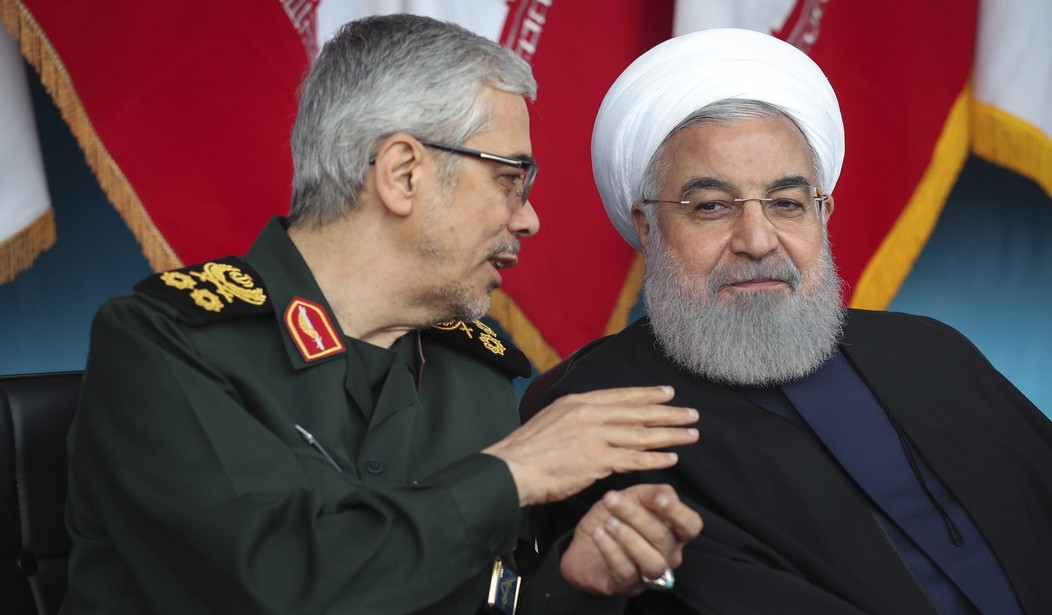“No good” is the first and obvious answer to the question, “What is Iran up to now?” But since that’s almost always the answer, it doesn’t do us much good.
A few data points:
• Iran facing ‘unprecedented’ pressure from international sanctions, Rouhani says
• Iran is moving missiles around by sea, and nobody knows exactly why
• Saudi oil tankers including one bound for US hit by ‘sabotage attack’ amid Iran standoff
• U.S. officials: Iran official OK’d attacks on American military
The first point is mostly old news, recently updated. Candidate Trump promised to pull out of Obama’s unratified (hell, un-submitted!) Iran Deal, and restore sanctions. He’s done just that, but in the last couple of weeks the administration has ratcheted up the pressure even higher. Last week a “senior U.S. diplomat” told Reuters that the State Department “will not grant any more waivers to any countries that would allow them to buy Iranian oil without facing U.S. sanctions.” That closed one loophole Tehran had used to continue generating cash. Late last week, the White House announced new sanctions on Iran’s metals industry, which is both a major employer and a source of hard currency.
The sanctions appear to be working, too. I already linked to Iran president Hassan Rouhani’s complaint about “unprecedented” economic pressure, and Oilprice.com’s Nick Cunningham notes that “Iran’s oil exports are plunging.” Tehran is looking to its OPEC partners to allow them production hikes, but without international customers, it won’t matter if they’re allowed to pump more oil.
So it’s pretty clear that the mullahs are feeling the financial squeeze — a welcome change from Barack Obama’s infamous largess.
Now, about those seaborne missiles…
Fabian Hinz (linked above) has a nice explainer up at RealClearDefense, even if it has more questions than answers. The story begins with a May 8 CNN report that Iran was “loading short-range ballistic missiles on boats,” but it was impossible to say whether they were for shipment to terrorist friends abroad, or whether Tehran had some mad plan to launch land-based missiles off of boats at American targets in the region.
Hinz continues:
Just as important as technical considerations is Iran’s lack of a regional strategic rationale for basing ballistic missiles on surface vessels. The main advantage of basing ballistic missile on surface ships is the de-facto extension of range. However, range is not an issue when it comes to Iran targeting U.S. forces in the region because the Islamic Republic already operates a large arsenal of missiles with ranges up to 2000km and a particularly impressive force of shorter-range precision-guided solid-fuel missiles. This arsenal puts all major U.S. bases in the region within striking range of the Islamic Revolutionary Guard Corps (IRGC). Systems like the Qiam, the Zolfaghar, the Hormuz, and the Khalij-e Fars are not only deployed with the aim of targeting U.S. American military bases in the region, but were also originally designed to do so.
Hinz concludes that smuggling is the likely explanation, and I thought so, too.
But then came word this morning about that mysterious attack on two Saudi oil tankers near the port of Fujairah in the Persian Gulf. The Sun report (also linked above) called it a “sabotage attack.” Saudi energy minister Khalid Al-Falih, quoted in the story, gave no other details. Did saboteurs sneak aboard? Were the ships victims of Iran’s weird ship-based missiles? Something else? We just don’t know, although the operation would seem to have Tehran’s fingerprints on it.
It isn’t unusual for Iran to be up to no good, but it is unusual for the Pentagon to dispatch an aircraft carrier strike group, an amphibious assault ship with Marines embarked, a Patriot antimissile battery, and a detachment of B-52 strategic bombers to the region, all at once, in response to a “number of troubling and escalatory indications and warnings.”
A good guess is that Tehran is probing for weak spots, attempting to spook its local OPEC frenemies into some kind of sanctions-busting subterfuge or to cause enough financial panic to force Trump to back down.
Two things make either result seem unlikely.
The first is the ancient ethno-religious animosities between Shi’a Iran and her Sunni Muslim neighbors. Shi’a and Sunni have been at each other’s throats for more than a millennium, and the Persians and Arabs have been at it even longer. Keeping Tehran bottled up works for Saudi Arabia’s national security and fattens Saudi bank accounts.
The second is that ever-widening sanctions on Iran are not only good for American national security and our allies’ regional security, but also dovetail with Trump’s policy of making trade more expensive for our strategic competitors.
Iran still has some nasty cards they can play, but the unofficial American-Israeli-Sunni alliance holds the aces. I read the last week’s weird headlines, not as a sign of Iranian strength, but of the Mullahs’ increasing desperation.










Join the conversation as a VIP Member